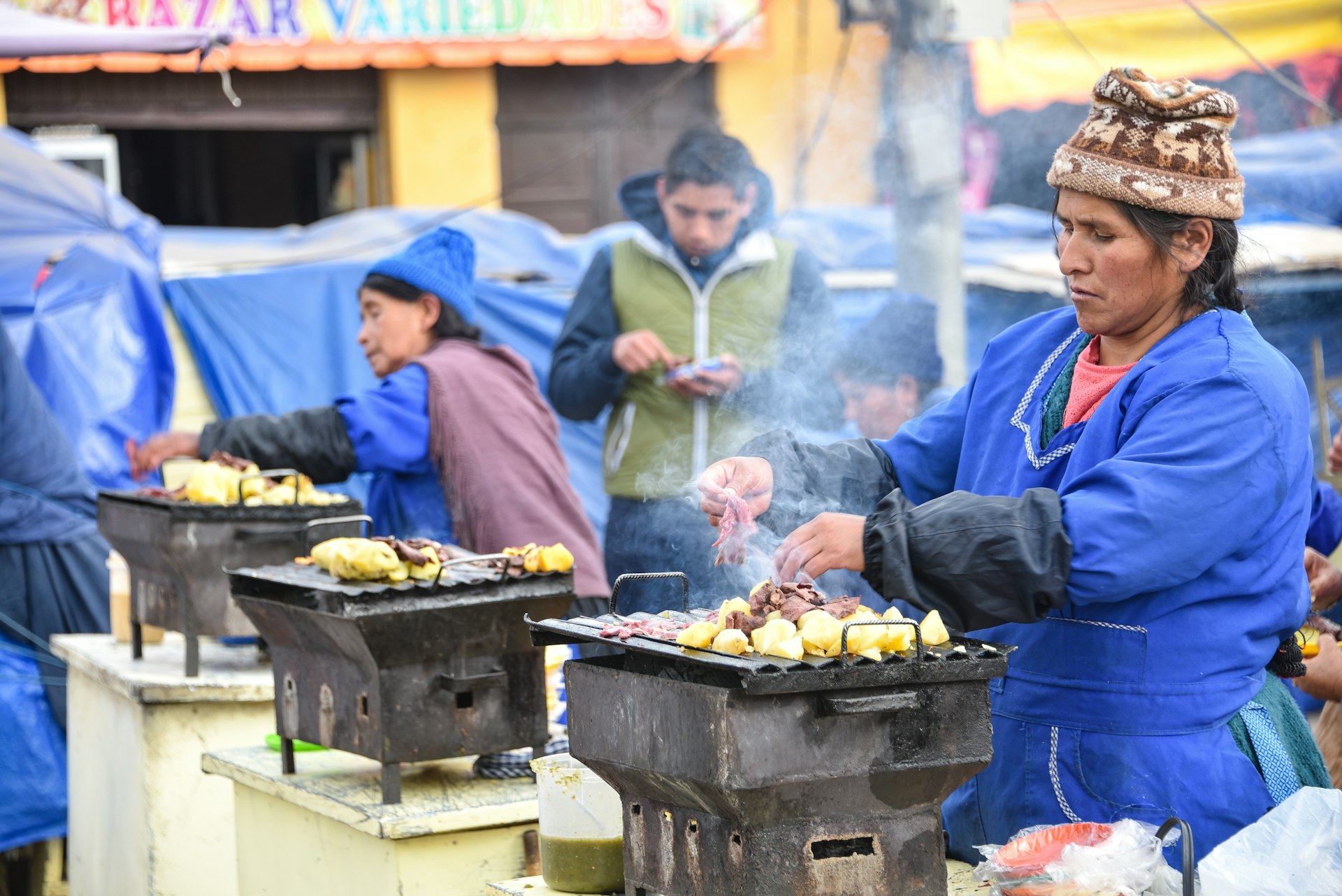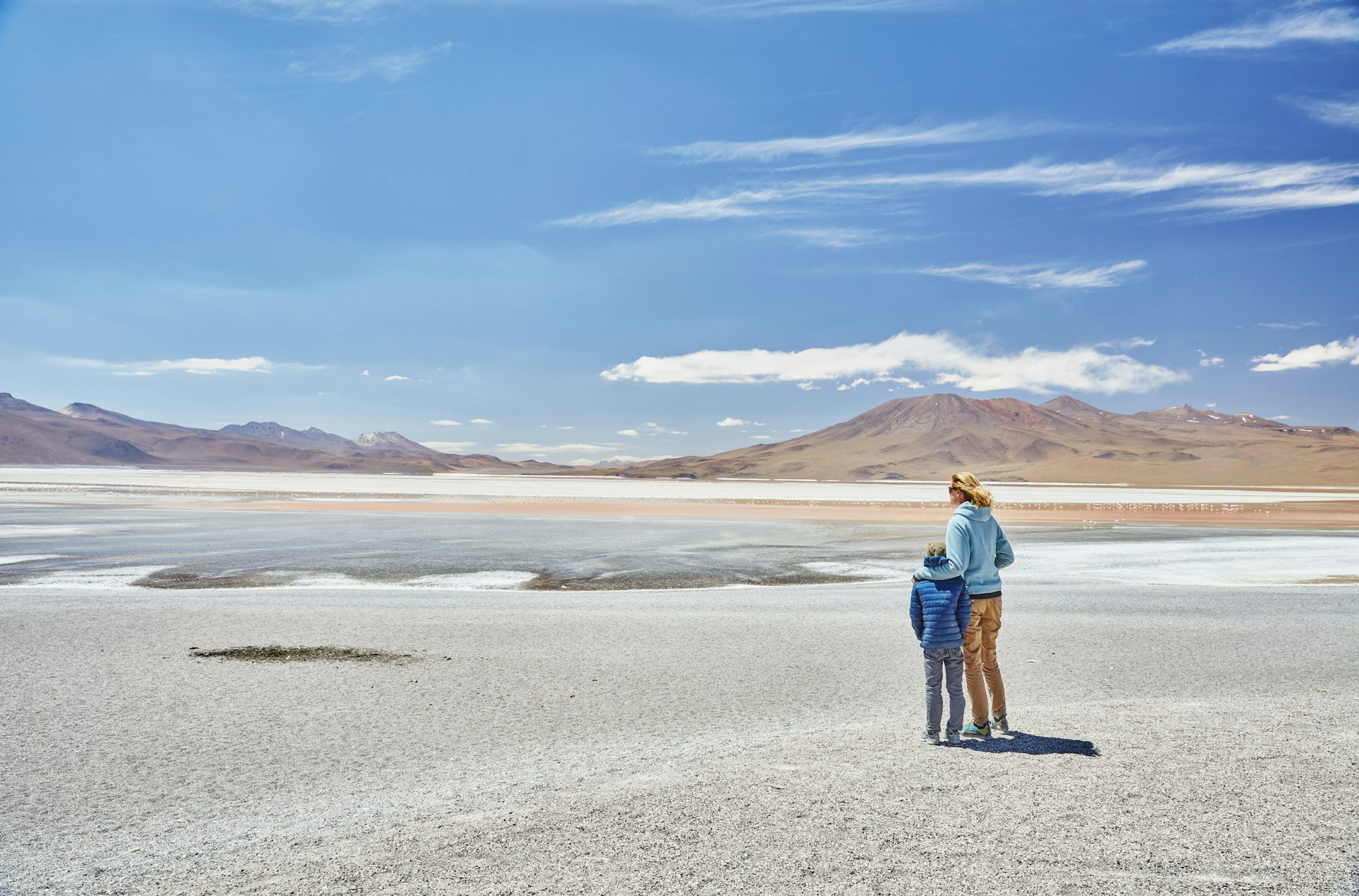Bolivia consistently ranks among the top value-for-dollar destinations in the Americas. With the country’s famously diverse terrain, you can explore Amazonian rainforests, ancient Tiwanaku ruins and some of the planet’s highest peaks on a relatively tight budget.
With lower living costs compared to Argentina, Brazil and Chile, international travelers can generally visit longer, eat more heartily and sleep for less money than in nearly every one of Bolivia’s South American neighbors.
Street food is incredibly inexpensive, hostels and guesthouses are among the most affordable on the continent and, if you mainly travel by bus, you can explore far and wide without making a serious dent in your wallet.
Of course, international flights to Bolivia aren’t cheap, cost for tours and entry fees can add up, and you’ll want to come prepared with the right gear for treks and national park trips to avoid having to hire or buy equipment locally. Here are our top tips on how to make the most out of your budget on a trip to Bolivia, as well as advice on when and where to splurge.
Daily Costs in Bolivia
- Dorm bed in a hostel: B$65 (US$9.50)
- Basic room for two: B$140 (US$20.40)
- Self-catering apartment (including Airbnb): B$160 (US$23.30)
- Local bus ticket: B$3 (US$0.45)
- Bus ticket from Santa Cruz to La Paz: B$110 (US$16)
- Coffee: B$16 (US$2.30)
- Sandwich: B$8 (US$1.15)
- Mid-range meal for two: B$130 (US$19)
1. Fly into Santa Cruz instead of La Paz
With its wild geography, colorful colonial-era buildings and proud Indigenous identity, La Paz captures the imagination of travelers far more than the modern and sometimes brash city of Santa Cruz.
Yet, cheap flights to La Paz are hard to come by, partly because of the tiny number of airlines serving the city’s high-altitude El Alto International Airport.
Because Santa Cruz is Bolivia’s most important business center, it welcomes the vast majority of international arrivals, meaning prices are cheaper and routes are less convoluted.
Not only can you save money by starting your Bolivian adventure in Santa Cruz, you’ll also start the trip at a lower elevation, allowing time to acclimatize as you travel to La Paz and the altiplano (highlands).
2. If you’re planning a multi-country backpacking trip, start somewhere else
In general, flying into Bolivia from abroad isn’t cheap since there is very little competition on international routes. Few airlines from outside South America fly here, so you’ll almost always be connecting through a neighboring country en route.
Start your backpacking trip in Argentina, Chile or Peru instead and travel overland to Bolivia to save money on your international flight. Bolivia also has a reputation for being more challenging to navigate than its neighbors, so many travelers prefer to come here once they have got used to the lie of the land, rather than using Bolivia as the launchpad for a pan-American adventure.
3. Stay in a local inn instead of the popular hostels
If you’re traveling as a couple or in a group, it can often be much cheaper – and more comfortable – to share a private room in a local residencial, alojamiento or posada (these names are used interchangeably for informal local inns), rather than paying for multiple dorm beds at a hostel.
These simple hotels are found everywhere, but room rates, cleanliness and standards of comfort can vary widely, so you’ll want to do some investigating (and ask to see a few rooms) before you commit.
Rooms are generally quite basic at these places, often with shared bathrooms, but you won’t be up all night dealing with a snoring neighbor – unless, that is, the neighbor happens to be your travel buddy or partner!
Also be aware that places advertised as “motels” in Bolivia are not cheap hotels, but rather rented-by-the-hour dives where unmarried couples go for sex.
4. Eat the local fast food to save bolivianos
Snacking on local fast food is not only a great way to appreciate Bolivia’s rich culinary traditions, you’ll also save some money in the process.
Salteñas – like yellow-orange empanadas (stuffed pasties) – are one of the most ubiquitous treats; they’re typically made with beef, pork or chicken plus olives, raisins and potatoes, and are sold for bargain prices.
Choripán (sausage sandwiches) and tamales (corn dough steamed in a corn husk wrapper, often stuffed with beef jerky) are also common, and can cost less than B$7 each.
In lowland Bolivia, be sure to try local treats such as cuñapes (cheese and yucca balls) or sonso de yuca (grilled mashed yucca with cheese), also available at pocket-pleasing prices.

5. Save your big meals for lunch
Sure, it’s great to end a long day of sightseeing with an epic dinner, but in Bolivia one of the best ways to snag a world-class meal at a bargain price is to make a reservation for lunch.
You can often find incredible set lunch deals in La Paz’s top restaurants, including Gustu, Ali Pacha and Popular Cocina Boliviana.
And since lunch is the most important meal of the day for Bolivians, you’ll find bargain set lunches at local restaurants across the country. Set meals known as almuerzo typically include a starter, main course, dessert and (occasionally) a drink, sometimes for as little as B$15.
6. Bring a water filter rather than buying bottled water
Though the tap water is chlorinated in some major Bolivian cities, it’s usually not considered safe to drink, and buying bottled water at B$7 a bottle can add up – both for your wallet and the environment.
We recommend traveling with a purifying water bottle such as the ones made by Grayl, LifeStraw or Astrea to reduce waste and save money.
7. Learn some key Spanish phrases to get better prices
Realistically, if you want to save some money in your everyday interactions in Bolivia, you’ll need to speak some Spanish.
Prices are often hiked for non-Spanish-speakers, so knowing basic phrases such as cuánto cuesta (how much) and hay algo más barato (is there anything cheaper) can help you negotiate for a better price and ensure you aren’t being overcharged. T
he Lonely Planet Spanish Phrasebook & Dictionary is a handy tool to keep in your backpack; you can study up on those long bus rides!

8. Take overnight buses to save
Speaking of long bus rides, the classic backpacker hack of traveling at night is a good way to cut costs in Bolivia.
You can book cama (reclining seat) or semi-cama (partially reclining seat) on flotas (long-distance buses) to save the cost of a night’s accommodation, and having a reclining seat also makes it easier to doze through extended journeys, which almost always take longer than the posted times.
When traveling to La Paz, however, don’t expect to get much sleep – the winding roads and vast changes in altitude can make this a very uncomfortable experience.
9. Pack appropriately so you don’t need to buy missing items
Proper outdoor gear isn’t cheap in Bolivia, but it’s 100% necessary if you plan to travel beyond the major cities, so bring your own from home.
Given Bolivia’s tropical latitude, many travelers are fooled into believing the weather will be warm, but this is certainly not the case at higher altitudes.
It may be steamy in the Amazon Basin, but it can be snowing in La Paz. Be sure to pack a winter jacket, some warm and windproof layers and reliable trekking and camping gear (if this will be part of your trip) so you don’t have to buy gear at a premium once you arrive.
10. Ride cargo ships through the Amazon Basin
Though not nearly as common as it once was, it’s still possible to hitch a ride through the Amazon Basin on a cargo ship – an incredibly cheap, somewhat uncomfortable and highly memorable experience.
These boats, of course, are not designed for tourists and information on departures is rarely posted publicly. To find a passage, ask around in the city of Trinidad near the Mamoré and Ibare rivers and see if any boats are open to taking on passengers.
You can also take a cheap (compared to most Amazon cruises) multi-day boat or rafting trip through the Parque Nacional Madidi from Guanay to Rurrenabaque, where you can stay in some excellent community-run jungle camps.
Travel agencies in La Paz, including the reliable Deep Rainforest, can make all the arrangements.

11. Summit a 6,000m peak for a fraction of the cost
Bolivia is a true wonderland for thrill-seekers, and you’ll find plenty of opportunities to go mountain biking, trekking and white-water rafting for affordable prices.
Above all, the country is noted for its mountaineering, with several peaks over 6,000m (nearly 20,000ft) in the Cordillera Real range within easy access of La Paz, including 6,088m (19,974ft) Huayna Potosí.
Best of all, climbing these giants is cheaper than ascents in many more famous mountaineering hubs.
Mountaineering is not without its risks, of course, so be sure to book with a reputable agency registered with the Asociación de Guías de Montaña y Trekking de Bolivia (AGMTB) and check the equipment before heading out.
Mountain guides are relatively affordable and the agencies they work for will provide everything you need – from food to gear, cooks, mules and porters – for B$415 t0B$550 (USD$60 to$80) per day.
Just make you’re properly acclimatized in advance so you don’t have to call off the climb due to altitude sickness.
12. Work or volunteer to extend your stay
Those wanting to stay longer in Bolivia can find opportunities to cheaply extend a stay by either volunteering or working in the country.
Many travelers find paid work at hostels, tour operators or bars, though the most common job is teaching English. Qualified teachers can expect to earn about B$3450 (USD$500) per month for a full-time position.
If you want to seek out volunteer positions, be sure to research the organization in advance and note that most operate on a pay-to-volunteer model, which can cost anywhere from B$1380 (USD$200) to B$6905 (USD$1,000) per month depending on the placement. Many volunteer organizations are based out of the central city of Cochabamba.
